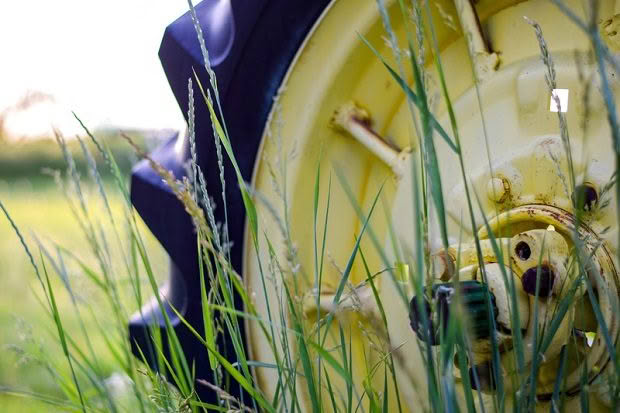What to look for if you’re buying a second-hand tractor

If your budget doesn’t stretch to a new machine, a second-hand tractor can be a great option, if you know the tricks to finding a good one.
Words: Nadene Hall
It can be daunting to buy a large piece of farm machinery when you have no or little knowledge. This basic checklist doesn’t require you to have specialist mechanical knowledge and will give you an indication of a machine’s suitability.
Dealers often sell older tractors that have been traded-in. Buying from a dealer does give you some protection under consumer law if the tractor you buy experiences a major failure, something you won’t get if you buy it from an individual.
1. Choose a common machine
If you are buying second-hand, it’s best to go for the more common brands like Kubota, John Deere or Iseki. These are still being brought into NZ which means getting parts for them will be easier. If something goes wrong with a brand that is unsupported, it can be extremely expensive to fix as you will need to import parts (if you can find them). The next problem is tractor parts tend to be costly and heavy, making freight another big expense.
Sometimes it can be impossible to get parts for some 1980s Japanese tractors. If you are considering buying one, ring a dealer who sells the same brand and ask if they can get parts. If they can’t, or worse, don’t have that model listed (rare but possible), don’t buy it.
Vintage tractors look beautiful. However, they won’t have modern safety features, and will be expensive to maintain, even for someone who is mechanically-minded.
If you are considering a particular tractor, ring the local dealer for that brand and ask a long-time staffer if they know of the model, does it have any common problems they’ve seen over the years, and can you get parts for it.
2. Check the hours
Tractor ‘age’ isn’t just measured by years but by how many hours the engine has done. First, check the hour gauge is ticking over. If it is, a very basic guide is:
1000-2000 – still young
3000-4000 – getting close to major repairs
9000+ – near the end of its life
It also depends on what kind of work the machine has been doing, how well it has been maintained (or not) and how much pressure it has been under in its working life. For example, if someone has been continually using the engine at the edge of its limits, it’s going to age faster than one used within its limits. Ask the owner how they have used it, and why they are selling it (eg, is it because they have found the tractor isn’t powerful enough for their needs).
3. Look at the seller
When you buy anything second-hand, it’s the seller who is the most important part of the transaction. Always go to see the machine in person and get a sense of the owner. Do they take care of their property? Is their machinery sitting in a dry shed? How long have they owned it? Has it been well-maintained?
These small things are all clues to the type of person you are buying from. If it’s clear their personality type is one who takes good care of their property, it’s a tick in favour of the machine.
Ask them if the machine has any issues and see what they point out. If you spot a fault they don’t point out, you need to gauge whether the person is deliberately misleading you or if their own inexperience means they are not aware it is an issue.
4. Ask to see the machine where it’s normally stored
You want to check the ground where it has been sitting to see if anything has leaked. You also want to know whether it is stored undercover or outside. Any kind of machinery, even something as big as a tractor, will deteriorate more quickly when left outside. Never store a tractor or any farm machinery outside.
5. Check the oil
Oil filters and the dipstick are on the side of the engine and usually easily accessed without needing to lift the hood. The filters should be clean and fairly new-looking – many owners write the date they last changed the filter on it and this should be within the last year. If the filter exterior is covered in oil, it’s a sign of a leak.
What colour is the oil on the dipstick? Preferably it should look clean. If it’s a white-brown colour, it indicates water contamination. This could be water entering the exhaust pipe, a sign of worn gaskets, a crack in the engine block or a symptom of other serious mechanical issues.
Tar black oil indicates a lack of basic maintenance.
6. Check the grease points
All tractors (and the machinery they run) have grease points and will be identified in the manual for the machine. Ask to see the manual if they have it, or find it online ahead of time so you can see locations for grease points for the machine you are considering. It can be hard to spot them as they are quite small.
Do they show signs of grease or are they dry? The manual will state how many hours of operation before greasing is due, but if the machine is under pressure, eg doing heavy work in the rain, greasing would need to be done more often.
Any metallic surface that moves against another need lubrication, for example, steering components. Do they look like they have been greased recently or are they dry?

7. Check the tyres
Tyres are one of the most common and expensive things you may need to replace on a tractor. If it’s an older machine, you need to check whether you can still get the right size tyres.
You want to check how much wear the tyres have left. You will need to measure the tread depth on a new tyre for a similar-sized machine, then compare to it to what you find on the day.
Is there damage to the tyre like cuts or missing chunks of rubber?
Look at the sidewall of the tyres and check for cracks and cuts. A cut can be repaired, but it’s not possible to repair cracks. Once the sidewalls deteriorate, the tyre may slowly deflate after being pumped up, until eventually the tube comes out a hole, ruining it. The tyre may also suddenly deflate. If someone has painted the tyres, look very carefully for cracks.
Look at the rims too. These can be damaged and/or go rusty and are another expensive item to fix or replace, if you can still get them.
8. Check the tie rods on the front wheels
This is the joint where the tractor axle meets the wheel. As you turn the steering wheel, these joints should be tight and move without wobbling or looking loose which indicates wear.
9. Look at the ground under the tractor
Is the grass dead or long, indicating the tractor has been sitting outside for a while? Is it showing signs where oil or other fluids have leaked?
10. Is there any sign of seepage from any part of the tractor?
Seepage could be oil or any other kind of fluid you see on the engine or any joint on the frame, tyres or linkages at the back of the machine. While a small amount of seepage may not be a serious problem now, it does indicate an issue that will have to be addressed at some point by an expert.
11. Ask for the tractor to be started from cold
Check they haven’t pre-warmed the engine (touch the bonnet or the engine) which can hide some faults. A tractor started from cold – if it starts – may puff black, white or blue smoke, make an odd noise, or run ‘rough’ before it warms up.
A little white smoke on start-up: normal for a diesel engine
White smoke once warmed up: unburnt diesel, engine not burning it properly possibly due to a problem with an injector pump or rings
A little black smoke while going uphill: normal as the engine is working harder
Blue smoke: an oil problem, a symptom of an engine nearing its end
Smoke rings occasionally while working: water in the fuel which can be hard to get out if it’s worked its way through your machine.
Most diesel tractor engines use glowplugs to pre-warm the engine. A tractor that is still hard to start after warming the glowplugs can mean they need replacing. This is an easy fix.
What can you hear? Old diesel engines can have a rhythmic ‘knocking’ sound that is normal for them, but any sudden knocking sound or one that becomes louder is a sign of an engine problem. It may be water in the fuel (don’t leave your tractor outside) or a problem with the head, the valves or the injector pump.

12. Rev the tractor
Check the manual and find the rev range for the PTO (power take-off) which runs attachments like a rear-mounted mower. While the tractor is sitting in neutral, bring the revs up to half that range, then let it drop. You don’t want to hear any kind of hesitation in the engine as it slows, which might indicate a pump problem.
13. Check the brakes
Some tractors have two brakes, one for each rear wheel. Engaging one but not the other gives you the ability to turn the tractor within its own width, very useful in tight spots.
Do the brakes work? When they are used together, does the tractor break evenly or does it ‘pull’ to one side, indicating one brake is not working as well (or at all) as the other?
14. Take it for a drive
Feel for vibrations, crunching when changing gears, and odd noises. A tractor in good working condition will move, sound and feel smooth.
If you slowly push the brake down (without engaging the clutch) does it jump out of gear? This can be a sign of a transmission issue.
15. Check every switch
Check that all the switches and buttons work. Something not working may be minor but may also indicate an electrical issue. An electrical fault is often not expensive to fix but can take a long (costly) time to diagnose.
16. Check the hydraulic pressure
If the tractor has a front-end loader bucket, you can use it to check how well the hydraulic pump is working (or not). When the loader bucket is sitting on the ground, if you engage it to go down while the tractor is stationary, it should lift the tractor’s front wheels off the ground. If it can do this, it indicates a healthy hydraulic pump.
17. Check the rear
![]()
The power take-off mechanism is a shaft turned by the tractor engine which provides power to attachments like a rear-mounted mower. Any attachment will be held in place by the 3-point hitching linkage (or arms). Check the 3-point hitch moves up and down easily.
Turn the PTO on, then turn it off. If it doesn’t stop turning when you switch it off, it can indicate an issue with the clutch or brake within the PTO. The labour to fix the potential causes is expensive as it involves pulling the tractor in half.
Other signs of a mechanical issue with a PTO are:
1. Look at the keyway (the shaft that implements slide onto) for signs of wear.
2. Are there any cracks in the outer housing covering the PTO?
3. What can you hear when the PTO is engaged? It should run smoothly – beware of whining, clattering, clicking and grinding, all signs of internal problems.
4. Does the PTO engage and disengage smoothly?
Love this story? Subscribe now!
 This article first appeared in NZ Lifestyle Block Magazine.
This article first appeared in NZ Lifestyle Block Magazine.
